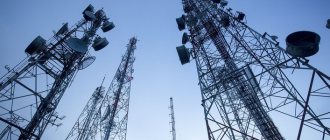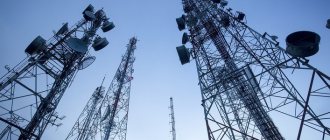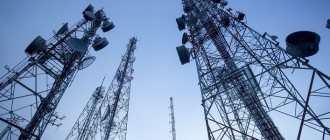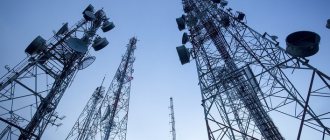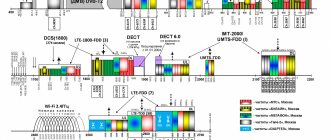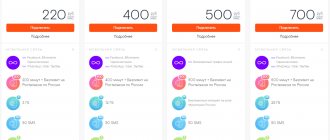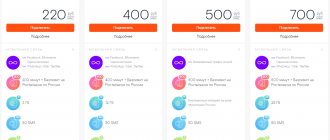Today, Russian mobile operators are actively expanding the coverage area of fourth generation networks. LTE is a term used to refer to networks with a throughput of at least 10 Mbps. 4G networks are a new communication standard, which is characterized, first of all, by fast connections and high quality voice calls.
List of LTE frequencies used by Russian mobile operators
The 4G networks of each domestic operator are located in a certain frequency range. The presented table contains information about LTE bands (from the English Band), which are supported in our country:
| Band name | Frequency |
| Band 3 | 1800-1880 MHz |
| Band 7 | 2620-2690 MHz |
| Band 20 | 790-820 MHz |
| Band 31 | 450 MHz |
| Band 38 | 2570-2620 MHz |
The LTE standard is not compatible with second and third generation networks, so special data transmission channels were allocated for it. Band is the frequency bands of any LTE network. The band number indicates the period when the given range began to be used in the world (there are currently 44 bands).
The bands presented in the table are used by each cellular operator. It should be noted that these frequency ranges are constantly expanding, which allows providers to provide Internet connections to a larger number of users.
In some cases, operators unite to build cell towers: a similar agreement was concluded in 2021 by Beeline and Megafon. Another example of cooperation was the agreement between Beeline and MTS, according to which the operators use common frequencies in the territory of some constituent entities of the Russian Federation.
The acquisition of bend frequencies occurs through open bidding, in which providers buy the right to broadcast their signal on certain channels. MTS, for example, spent 4 billion rubles on the 2500 MHz band, distributed throughout the Russian Federation except the Moscow region and Crimea. Tele2 was the first to launch 4G in the Kaliningrad region and a number of other regions of our country at a frequency of 450 MHz.
Full review
Now let’s pay a little more attention to each moment of this modem. Fortunately, the Iota network was brought to our city a long time ago and I had the opportunity to fully enjoy all its advantages. Yes, yes, compared to other operators, the Yota phenomenon was not only convenient, fast and reliable for us, but also inexpensive. And their flexible range of tariffs with dynamic changes - when I was a student, this was a real revolution in saving money on doshiraki.
How can you use them?
And no matter how we tried to use them. This is a really cool and convenient thing. Here are the main areas of application:
- For the home - even without comment. Most people use it for this. Particularly suitable for a small apartment or workplace.
- Office - I remember we stopped at the office one day. And legal entities in that building were prohibited from entering third-party Internet providers - either use the one that was imposed, or leave, because... It was expensive to install a new wire. As a result, we solved the problem simply by installing just such a modem. He saved everyone and completed his task.
- Dacha and new buildings - in one place I moved for the reason that it would be suitable where none of the wired Internet providers had yet arrived. We stuck it in and waited for our turn.
- Auto. A taxi driver's dream, and all you need to do is plug the USB into the socket. Clearly, for cities with good coverage. Perhaps the suburbs are also relevant for the West, but just beyond the Urals there is no connection on the highways.
- Business trips. If you often travel around cities, take this modem and don’t worry about your important VKontakte and YouTube. In populated areas, Yota coverage is available almost everywhere. For those who want to check, YOTA COVERAGE CAN BE VIEWED HERE. While doing daily rentals, I often saw business travelers with Iota. Moreover, from completely different parts of our country - a direct sign of quality and recognition.
- Mobile router. And although it does not have a built-in battery, it is not difficult to power such a little thing with some kind of PowerBank for the whole day and beyond. You can take it with you even on walks, picnics and fishing trips (men, it’s been checked!!!).
Appearance
I have already shown you the main options for external design above. This is a convenient and compact device in all respects. And the rotating magazine will force it to fit into any “crack”.
Equipment:
- A simple beautiful cardboard box - without luxury.
- Modem.
- Manual.
All! The simplicity of Apple has crept in here too, nothing superfluous. If anyone is interested in reading all versions of the operating manuals, there will be a section with instructions below, scroll there.
Particular attention should be paid to the rotating USB plug - conveniently hooked, installed, and plugged in. Behind it is a slot for a SIM card (micro SIM form factor is used):
The modem is locked to use Iota SIM cards only! Others will come here only after difficult manipulations (it’s easier to use other modems).
On the back side of the plug when folded, there is also a duplicate micro USB connector - here you can plug an extension cord and install the modem exactly as it is convenient for you (for example, I have seen cases of throwing it out the window on the cord).
4G LTE networks in Russia
Now you can familiarize yourself with the table, which presents the current characteristics of fourth generation networks in the Russian Federation.
| Operator | Frequency (upload/download), MHz | Duplex | Band |
| Yota | 2500-2530 / 2620-2650 | FDD | Band 7 |
| Megafon | 2530-2540 / 2650-2660 | FDD | Band 7 |
| Megafon | 2575-2595 | TDD | Band 38 |
| MTS | 2540-2550 / 2660-2670 | FDD | Band 7 |
| MTS | 2595-2615 | TDD | Band 38 |
| Beeline | 2550-2560 / 2670-2680 | FDD | Band 7 |
| Tele2 | 2560-2570 / 2680-2690 | FDD | Band 7 |
| MTS | 1710-1785 / 1805-1880 | FDD | Band 3 |
| Tele2 | 832-839.5 / 791-798.5 | FDD | Band 20 |
| MTS | 839.5-847 / 798.5-806 | FDD | Band 20 |
| Megafon | 847-854.5 / 806-813.5 | FDD | Band 20 |
| Beeline | 854.5-862 / 813.5-821 | FDD | Band 20 |
In addition to the five federal operators, there are also regional ones, each of which has its own frequency network.
Upper and lower frequencies
From a financial point of view, the development of LTE networks at lower frequencies (less than 2000 MHz) is most profitable for operators. Such frequencies penetrate buildings better, but are not able to provide high-speed connections to areas with high population density.
The functions of the upper frequencies are opposite to the functions of the lower ones, so the best option for a high-quality connection is a combination of both frequency channels, which allows you to get rid of “shadow” areas over large spaces.
Also in megacities, there is a tendency to install special devices on the roofs of office buildings to facilitate the spread of high-speed networks indoors.
Basic LTE modes
The LTE standard is divided into two types: TDD and FDD.
The first implies temporal (from the English Time) division of the signal, and the second - frequency (from the English Frequency). FDD is a more convenient communication mode because, from the point of view of everyday use, it is more stable.
The difference between these concepts lies in the method of loading and unloading data. Thanks to FDD, parallel processing of incoming and outgoing Internet traffic occurs.
Imagine that a user is watching a video on YouTube and at the same time uploading an entire album of photos to the cloud storage. Watching a video will be considered a download operation, and sending a photo will be an upload, and in FDD mode the gadget distributes both operations over different frequency channels.
For example, LTE from the Russian Megafon operates at a frequency of 17 MHz, 11 of which can be used for downloading content, and the remaining 6 for uploading.
Separate traffic processing increases the stability of the speed of each individual process, thereby ensuring a better connection.
TDD processes traffic sequentially. In other words, over the same 17 MHz, both downloading and uploading of data will be carried out - but without separation, but alternately in one channel. The disadvantage of this mode is possible “jumps” in speed.
Currently, Russian cellular operators are striving to combine the operation of TDD and FDD stations. By combining modes into one network, providers increase the overall connection speed.
Best models
Currently, there are 2 main models on the market for Yota modems with Wi-Fi. The differences are minimal, both are close relatives, but for the sake of introduction before the main part of the review, it is worth paying attention to them.
Classic
Classic model. The design is almost indistinguishable from the first modem models that came without a Wi-Fi module (only a little longer). It is with this that most people associate Iota modems. Unique design, excellent work, the magic of this operator. Main characteristics:
- 4G support.
- Up to 8 connected devices.
- Standards: IEEE 802.11 b/g/n.
- Dimensions: 89x29x12 mm, weight: 29 g.
- A cut-down USB with a rotating mechanism - you can even place it vertically.
- Antenna – built-in, no options.
- Possibility of power supply via USB, directly via contact or cord.
- Support – all modern Windows, MacOS and Linux.
YOTA 4G LTE W8
An updated version of the Yota 4G LTE modem with Wi-Fi in a new case with minor differences. What we have at first glance:
- Connect up to 10 devices
- Full size USB port
- He turned white!
- Otherwise, no changes.
Other modems
Of course, the provider has prepared other options - there are also more functional models. But due to the fact that this article is still about modems, and these other models are more similar to typical home models of wired Internet, and people usually call them routers, they were not included in this review. But for reference, Yota users do not live with a single “flash drive”.
LTE-advanced technology (4G+)
LTE-advanced is an “advanced” 4G network and is designated by Russian operators as 4G+. Although this name emphasizes the increase in speed of the new standard, it is not correct, since LTE-A in its actual performance is regular 4G. What is called 4G in Russia is significantly inferior to the nominal standards of fourth generation networks.
The advantage of the advanced standard is the summation of all frequencies owned by the cellular operator, which reduces the “sag” factor in the data transmission channel. By merging several band 7 bands into one, Megafon was able to increase the theoretical connection speed to 300 Mbit/s.
If we add band 3 frequencies to the frequencies of band 7, then the data transfer speed will be 450 Mbit/s (40 MHz + 20 MHz = 300 Mbit/s + 150 Mbit/s). Unfortunately, the actual throughput of advanced channels is lower than declared and corresponds only to nominal 4G standards.
Any cellular operator that has the appropriate license and the necessary equipment can use various frequency channels. Now there is a tendency to expand channel capacity, the volume of which depends on the frequency range. It is also worth noting that to support LTE-A, the user’s device must have special technical characteristics.
Yota tariff for modems
We come to the most interesting part - the tariff plan for modems and routers. After all, many subscribers use Yota 4G high-speed Internet only on computers. However, using a router with Internet distribution, you can access the network from any device. The tariff plan for routers and modems is very flexible - it provides a solid gradation in speed:
- 64 kbit/sec – completely free access, albeit low-speed;
- 512 kbit/sec – Yota 4G internet at this speed will cost you only 400 rubles/month;
- 640 kbit/sec – the subscription fee for this channel will be 450 rubles/month;
- 768 kbit/sec – for access to the network at this speed you need to pay 500 rubles/month;
- 896 kbit/sec – the next gradation of speed for 550 rubles/month;
- 1 Mbit is a quite comfortable speed for surfing, the subscription fee is 600 rubles/month;
- 1.3 Mbit/sec – subscription fee will be 650 rubles/month;
- 1.7 Mbit/sec – network access for 700 rubles/month;
- 2.1 Mbit/sec – subscription fee is 750 rubles/month;
- 3.1 Mbit/sec – good speed for surfing and watching videos for 800 rubles/month;
- 4.1 Mbit/sec – monthly fee is 850 rubles/month;
- 5 Mbit/sec – a solid channel for 900 rubles/month;
- 5.7 Mbit/sec – high-speed access for 950 rubles/month;
- 6.4 Mbit/sec – excellent speed for 1000 rubles/month;
- 7.1 Mbit/sec – fast Internet Yota 4G for 1050 rubles/month;
- 7.8 Mbit/sec – the subscription fee for the channel will be 1100 rubles/month;
- 8.5 Mbit/sec – powerful channel for 1150 rubles/month;
- 9.2 Mbit/sec – quick access to network resources for 1,200 rubles/month;
- 10 Mbit/sec – such a channel will cost 1250 rubles/month;
- 12 Mbit/sec – high speed access to Yota 4G for 1300 rubles/month;
- 15 Mbit/sec – high-speed Internet for 1350 rubles/month;
- The maximum available speed is 1400 rubles/month.
Please note that there are no traffic restrictions here. But the declared speed may differ from the real one for various reasons. At any minute you can set one speed or another - the subscription fee will be recalculated automatically .
In addition, Yota 4G Internet can be connected for 2 hours for 50 rubles or for 24 hours for 150 rubles. Annual tariffs are also provided - 5,400 rubles/year at a speed of 5 Mbit/sec, 6,900 rubles/year for 10 Mbit/sec and 9,000 rubles/year for maximum speed - the discount is quite significant.
Rate this article
4G speed
It is worth understanding that the actual connection speed almost always differs from the nominal one. The theory does not take into account factors such as landscape, remoteness of cell sites, or the presence of the user in the building - such conditions interfere with the connection and significantly reduce its quality.
The speed of data transfer also depends on the operator’s workload: the more users have access to fourth-generation networks, the lower the speed indicators. The speed of the Internet connection in wireless networks is determined by the width of the frequency range, as well as the implementation of the communication duplex.
These specifications vary by operator. Although some providers guarantee 300 Mbit/s, the average actual speed is only 75 Mbit/s (Tele2, MTS and Beeline).
The already mentioned tandem of Beeline and Megafon recently began the transition to the LTE-advanced standard, which made it possible to increase speed to 160 Mbit/s in some coverage points.
Now such a standard is presented in Moscow and St. Petersburg, but the regions will have to wait a long time for it: the total distribution of 4G+ throughout Russia is now impossible for two reasons.
The first is the cost of the required equipment, and the second (follows from the previous one) is that as the coverage area increases, the load on existing cell towers will increase, that is, the average speed will only decrease.
Since the speed of the connection depends on the width of the frequency range, we can say that today Megafon is in the most advantageous position, which, after absorbing Yota, added channels of the acquired company to its own frequencies.
Theoretically, the Megafon network can operate on a 40 MHz channel and accelerate in FDD mode to 300 Mbit/s, but since part of the channel is given to subscribers of the subsidiary Iota, the actual speed is approximately 100 Mbit/s.
If we compare networks of the third and fourth generations, the latter have several times higher speeds: an average of 80 Mbit/s versus a maximum of 3 Mbit/s. HSPA+ was able to overclock 3G to 45 Mbps, but these figures still lag behind 4G.
Yota tariff for smartphones
We have already talked about the Yota 4G coverage area and the subscriber devices used. Now we need to talk about tariffs. First, let's look at the tariff for smartphones. There is only one, but it is flexible and customizable:
- 200 minutes of calls within Russia and 2 GB of traffic – the subscription fee is 370 rubles/month;
- 500 minutes of calls within Russia and 6 GB of traffic – the monthly fee is 450 rubles/month;
- 800 minutes and 12 GB of traffic – subscription fee is 780 rubles/month;
- 2000 minutes and 15 GB of traffic – the subscription fee will be 1250 rubles/month;
- 5000 minutes and 30 GB of traffic – costs 2850 rubles/month.
Many other combinations are available.
For another 50 rubles/month you can connect to unlimited SMS, and for 15-60 rubles/month you can connect to unlimited applications that allow you to get unlimited access to social networks and instant messengers. In domestic Russian roaming, the cost of services does not change . But if you spend more than 30 days in another region, the subscription fee will change in accordance with special roaming rates - they are 20-30 percent more expensive).
If the package of minutes is exhausted, you can connect an additional package - 100 minutes of communication will cost you 180 rubles. If the package is not needed, then the cost per minute will be 2.5 rubles. As for SMS and MMS, they will cost 2.5 rubles/piece.
Further development of LTE
Despite the launch of testing of fifth generation networks in the world, some regions of the Russian Federation still do not even support 3G. In connection with this circumstance, it is worth predicting, first of all, the widespread development of LTE technology. Also, fourth-generation networks represent a non-alternative way of accessing the Global Wide Web in a number of Russian regions, which encourages domestic cellular operators to develop the 4G standard.
In some cases, a wired connection is simply impossible, which contributes to the spread of wireless technologies: the capabilities of cellular stations can be expanded thanks to special signal repeater antennas. The user can independently purchase such an antenna. It is important to consider that each repeater only works with certain frequencies and mode (FDD or TDD).
Yota tariff for tablets
Tablet computers are not typically used for voice communication or sending messages. Therefore, the Yota tariff for tablets does not include any additional packages - it only contains high-speed unlimited Internet . The tariff plan is activated for a day, a month or a year. More details about tariffs:
- “Day” - a day of access to high-speed Internet Yota 4G will cost 50 rubles. An excellent solution for those who need rare access to the network (for example, only on weekends);
- “Month” - payment for this period is 590 rubles, the possibility of automatic renewal of the package is provided;
- “Year” is the most economical access for 4,500 rubles. Suitable for those who need access to the Yota 4G Internet on an ongoing basis.
If you suddenly want to make a call, a minute of voice communication will cost 3.9 rubles/min. The cost of sending SMS or MMS is 3.9 rubles/piece.
To manage tariffs on smartphones and tablets, a special Yota mobile application is used, available for Android and iOS devices.
